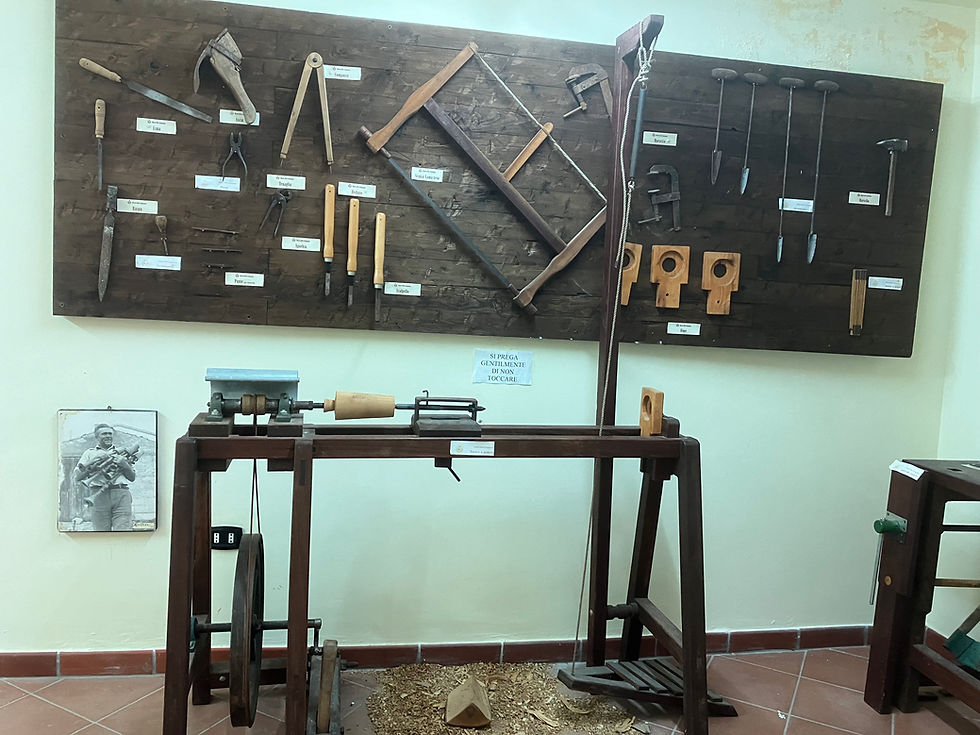(e ci sono ancora le lumache)
- Antonio Forte
- Jul 4
- 5 min read
(and there are still snails)...As I embark on my summer travels--una vacanza di lavoro ('a working vacation') I explained to my friend Ciro, as he zipped us through the strade pazze ('crazy streets') of Napoli--I find myself again at the Museum of Loss and Renewal in Molise. After the hustle-and-bustle of public transport, the 'hurry-up-and-wait' of airports, and especially after seemingly wading through the thick, hot, frenetic energy of Napoli, the vibrantly lush mountainsides of Molise are a much-welcomed reprieve. As soon as I arrived in Collemacchia and smelled its fragrant air, a wave of calm swept over me.
My mind is filled with calm; my skin is filled with heat from the afternoon sun; my lungs are filled with the fresh mountain breeze; my heart is filled with gratitude; and my spirit is filled with possibility. Re-filled, I should say. And the snails seem to be here to welcome me, right where I left them last summer.
![[Caption: landscape with snails...or, snails with landscape. First day at the studio in Collemacchia, Molise.]](https://static.wixstatic.com/media/e140d9_32a3eafa405245c88d39e01994fe64ed~mv2.png/v1/fill/w_980,h_1307,al_c,q_90,usm_0.66_1.00_0.01,enc_avif,quality_auto/e140d9_32a3eafa405245c88d39e01994fe64ed~mv2.png)
Snails are interesting creatures, and I have been a little obsessed with them for the past three years, ever since my first residency at the Museum and my first conversations with fellow resident artist Madison Mondshine. They are one of the few animals that build their own homes. And they build them from the inside out. As the snail's soft body grows, it secretes its building material, making the entrance wider in a continual spiral. This spiral is an example of Mother Nature's harmonic laws in action, and can be expressed or illustrated by simple mathematical formulas. The Fibonacci sequence and the rettangolo aureo ('golden rectangle') are just two examples of this expression; natural geometries which have been used for thousands of years in architecture and in music. A reader familiar with my previous work may begin to see where this is leading (and there are still snails).
One of the most intriguing species of snails is the Chrysomallon squamiferum. Its name is a combination of Greek and Latin. Greek χρυσά (chrysá meaning 'golden') and μαλλιά (malliá meaning 'hair'), and Latin squamiferum meaning 'scaly;' although, I think it should be squamiferrum, meaning 'iron scales.' This species was discovered in 2001, only lives around hydrothermal vents in the Indian Ocean, and is unique in that its shell and scale-covered foot utilize iron and pyrite (hence the 'golden'), unlike other mollusks which use calcium to make up their shells. They are beautiful, peculiar creatures, and also endangered (and there are still snails).
I have been encountering and pondering snails of all sorts for the last few years, continually being inspired by their slow, deliberate, methodical strength. They have come to symbolize for me an inner resolve: to continue my work unabatedly, unabashedly; to carry my own home and to build it from the inside out (and there are still snails).
Before landing in Italy, I made a short sojourn in the United Kingdom in order to visit some dear artist friends. One stop included the Garden Museum in London. The Garden Museum is housed in a former church, much like the fishing museum on the rocky beach in Hastings, both complete with stained-glass windows (and there are still snails).
[Caption: Both the horrific and the magnificent at the Garden Museum in London.]

[Caption: Looking out at the English Channel on the flint-and-chalk beach of Birling Gap/Seven Sisters.]
[Caption: Top: a foggy hike in Hastings; a restaurant in St. Leonard's (the name was much better than the food). Bottom: boat in a church (fishing museum) on the beach in Old Town, Hastings; proof that Sally the seagull really does sell seashells by the seashore, in Old Town, Hastings; view from the top of Birling Gap/Seven Sisters.]
[Caption: Top: Salvador Dalí's Lobster Phone and one of Etel Adnan's leporello books at the Tate Modern in London. Bottom: Rebecca Louise Law at the Garden Museum. At the bookshop in Naploli Centrale train station, Danielle Steel knew where I had been.]
Within the Italian region of Molise are two provinces: Campobasso and Isernia. A book I return to again and again in the Museum's library is Franco Valente's Luoghi antichi della provincia di Isernia ('Ancient places of the province of Isernia'). It is a vast treasure trove of the histories of the various borghi ('towns' or 'villages') of Isernia, including those that my great-grandparents came from over a century ago. The names of these places are rife with the toponym Sannio ('Samnium'), and their histories seem to begin with the Samnites. Several of these borghi contain extant ruins, archaeological sites, built by the Samnites over 2,000 years ago. Two caught my attention yesterday: Vastogirardi and Pietrabbondante. Valente explains that the temple layouts at these sites use simple leggi armoniche ('harmonic laws') that are pitagoriche ('Pythagorean') and nod to Euclide ('Euclid'). For example, if one takes the ratio of the long side of Vastogirardi's temple to its short side, the result is 0.618, which is the Golden Section. In mathematics the Greek letter phi is used, so that:
φ=(1+√5)÷2=1.618...
and
φ=(1-√5)÷2=0.618...
This is also illustrated in great depth in Matila Ghyka's The Geometry of Art and Life, another book found in the Museum's library.
If one starts with a line and continually multiplies each new line, set at 90° to the previous, by φ (1.618...), the result will be a spiral that follows the Golden Ratio (and there are still snails).
[Caption: From my notebook: The Golden Rectangle, inscribed with Pythagorean triangles (left); the Fibonacci Sequence as it spirals into infinity (right).]































Comments